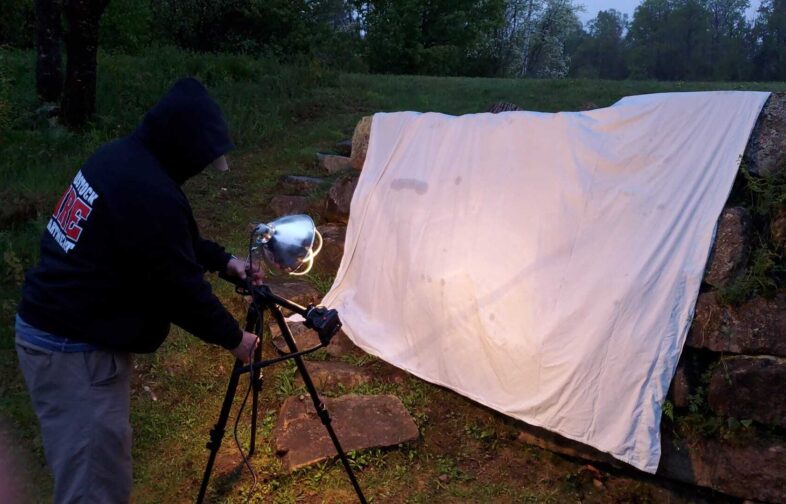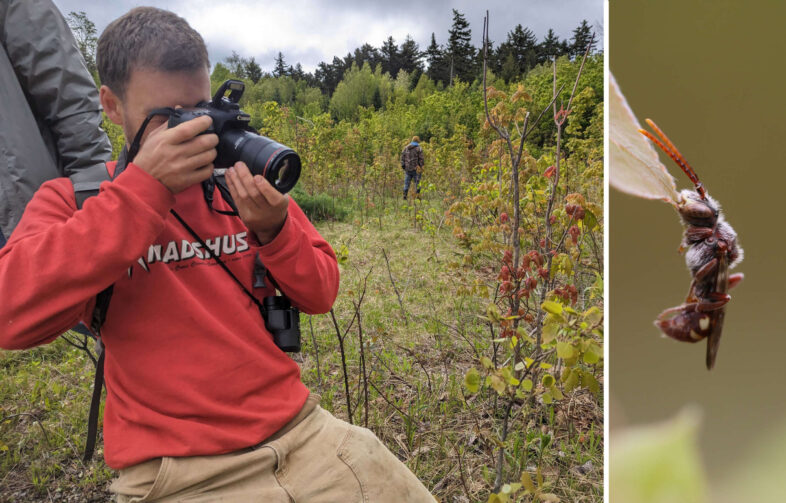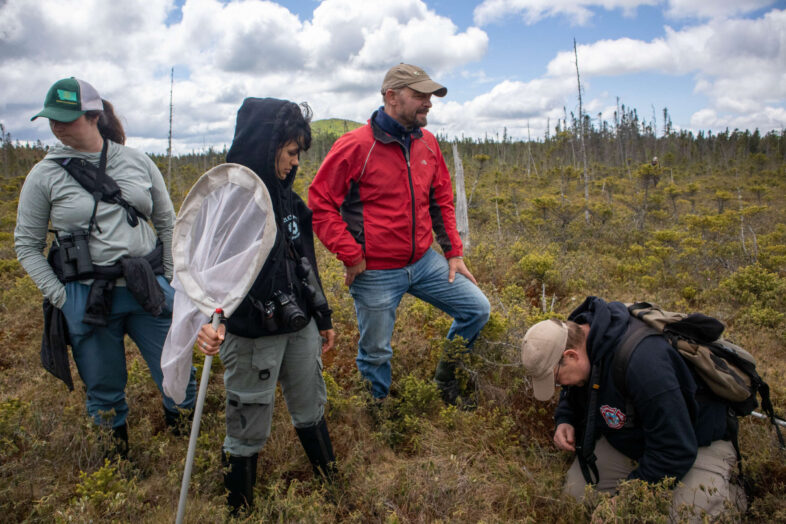After the jolting extremes of a northern April, the month of May adds a bit of predictability to life in our region: trout lilies bloom under the hardwood canopy, American Toads join the chorus of Spring Peepers, and the VCE staff transforms into the Green Mountain Goatsuckers. Our Birdathon-turned-Biothon team has always embraced a check listing challenge, but we significantly raised the stakes with this year’s species count: while aiming to maximize observations of all winged creatures in a 24-hour period, we purposely avoided known hotspots where high numbers would be virtually guaranteed. Instead, we sought out an under-surveyed area where new data could help close gaps in Vermont’s biodiversity knowledge base.
Gathering at Groton State Forest on a late-May afternoon, we intended to begin our bird and butterfly lists, pause for supper, and then plug in the moth light. The use of this lure would boost us toward our goal of 200 winged species. With dozens of moth varieties added to the count overnight, the next day would be a cakewalk!

VCE Conservation Biologist Kent McFarland adjusts the moth light.
Moths Lay Low
And then Mother Nature doubled down on the challenge. At our 5 p.m. start time, it was 45 degrees and pouring rain. Dusk descended, and no self-respecting moth would be caught out in the maelstrom. The next day dawned blustery and cold. (Did someone say May was predictable?) Birds were quiet, butterflies were hunkered down. The Goatsuckers spent the day working for every species we could find. We left no stone—or leaf—unturned.
Every Leaf Has Two Sides
Although slowing down for a time-limited and pledge-based fundraiser is unorthodox, it turns out that our deceleration strategy worked. Shifting the mindset from “Get a move on!” to “What’s the hurry?” was hard at first; but if there was going to be any tallying at all, we were going to have to look intently, carefully, thoroughly. As luck would have it, the blooming apple trees provided an irresistible feast for warblers, Purple Finches, bumblebees, flower flies, and other pollinators who foraged among its flowers, oblivious to the weather, and drew us in to observe their activity.
Excitement Ramps Up
Nathaniel Sharp recalls seeing Spencer Hardy, our resident bee expert who has observed and identified thousands of bees in Vermont, suddenly crouch down to the ground and whip out his macro lens in one swift motion while saying something to the tune of, “I’ve never seen this before!” He had found a sleeping Nomad Bee.

Spencer Hardy photographs a sleeping Nomad Bee (pictured right).
Nearby Peacham Bog enticed several team members on a quest for the state’s second record of Bog Elfin (the first having been found mere days before by our colleague Bryan Pfeiffer and featured on the front page of the Boston Globe). When Steve Faccio captured an unidentified elfin that then disappeared before it could be closely examined, Kent McFarland’s voice rose an octave as he exclaimed, “I’m REALLY excited now!” Maybe he was jumping up and down, maybe not. Our memories are foggy, and our imaginations inspired but, knowing Kent’s sense of wonder at all things winged, the likelihood is high.

The Green Mountain Goatsuckers’ bog team pauses to scan the vegetation for signs of movement.
Biothon 2023 was the first VCE field experience for several of our newest staffers. Among the day’s pleasant discoveries was that Toni Luff and Laura Prothero are exceptionally observant. They may not have known the scientific classification of the critters they found, but their eagle eyes added substantially to our species list. Conservation Biologist Desiree Narango was thrilled that Toni, our brand-new administrative coordinator, “found me a lifer lady beetle!”
All told, we managed to count 190 species, a nightjar’s “whisker” from our goal of 200. Of these, 40 species of insects had not previously been recorded in Groton State Forest: six beetles, six moths, four butterflies, and a host of flies, aphids, sawflies, and others. And in spite of the unseasonable conditions, we also recorded 70 bird species, including only two raptor species but 16 warblers. View the Goatsuckers’ species list here (pages 3–6).
We are grateful to every VCE friend who participated in this year’s Biothon. Whether you birded or butterflied, supported someone else’s efforts, or pledged support for the Green Mountain Goatsuckers, you helped to make our spring fundraiser a success. Thank you!
— Susan Hindinger, July 2023
